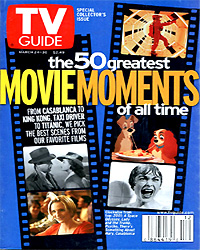
|
Movie Moments (of all-time) by TV Guide Part 3 |
For purposes of comparison, the TV Guide list includes almost all of the greatest movie moments published previously on the "Greatest Films" website, at Greatest Moments and Scenes, and at the 100 Greatest Film Scenes (in 10 parts). films that "The Greatest Films" site has selected as the "100 Greatest Films". |
TV GUIDE's
50 GREATEST MOVIE MOMENTS
(Ranked in Reverse Order)
| 25. Network (1976)
- MAD AS HELL With the most memorable rallying cry in Hollywood history, demented anchorman Howard Beale (Peter Finch), the "mad prophet of the airwaves," articulated the rage and frustration of a society dehumanized by bureaucracy, the corporate world and, most of all, television. The phrase? "I'm as mad as hell, and I'm not gonna take this anymore!" Beale's declaration galvanized his viewers, and in a scene still capable of sending chills down the spine, the dark streets of New York are filled with the phrase shouted from the city's windows. Screenwriter Paddy Chayefsky's defiant call has since become part of the American lexicon of outrage and catharsis. Finch is electrifying, and his performance won him an Oscar, bestowed posthumously: Finch died of a heart attack two months before the ceremonies. |
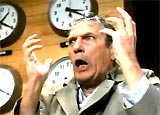
|
| 24. GoodFellas (1990)
- THE FUNNY GUY The tracking shot through a literally mobbed restaurant is a marvel, but Joe Pesci's terrifying "I amuse you?" speech stands tallest in this picture. As Tommy DeVito, the gangster with a short stature and a fuse to match, Pesci improvised the dialogue after telling director Martin Scorsese about an encounter he'd experienced. As Tommy entertains a group of wiseguys with profanity-laced stories, Henry (Ray Liotta) innocuously calls him "funny." Suddenly, Tommy turns scary: "Whaddaya mean I'm funny?...Funny how? I mean, funny like a clown? I amuse you?" Countless actors and directors have tried to copy this blend of humor and menace. But none can sit at the table with Pesci and Scorsese. |
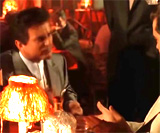
|
| 23. Private detective Jake Gittes (Jack Nicholson) finds himself in over his head as he unravels an enormous land swindle in booming pre-World War II Los Angeles. "You may think you know what you're dealing with," John Huston's L.A. bigwig tells him. "But believe me, you don't." The audience is in Gittes's boat as it navigates Robert Towne's luminous, layered script, but the mystery in Roman Polanski's neo-noir classic is impenetrable until Gittes literally slaps a scandalous plot point out of a beautiful widow Evelyn Mulwray (Faye Dunaway): "She's my daughter [slap]...my sister [slap]...She's my daughter [slap]...my sister [slap]...my daughter [slap]. She's my sister and my daughter!" Even Gittes, who has had a belly full of human nature, is thunderstruck. |

|
| 22. Has there ever been a more deceptively simple beginning to a movie? From the very first frame, the film boasts some of the most dazzling images ever put on screen, courtesy of a 25 year-old genius named Orson Welles. The camera focuses on a snow-covered house, pulling back to reveal a snow globe in a man's hand. The word Rosebud is whispered: the globe drops to the floor and shatters. A distorted shot of a nurse entering the room is reflected in the glass. She pulls a sheet over Kane's head, the lights flicker out, and the mystery of Rosebud begins. So, too, does a new, more sophisticated era in Hollywood filmmaking. |

|
| 21 . Stanley Kubrick's landmark film overflows with celestial sights, from mysterious monoliths to a spaced-out star child. But the defining moment in this cosmic classic is the dismantling of the calculating computer, HAL 9000. As the machine's logic and memory circuits are disconnected by Keir Dullea's astronaut, Dave, HAL's maddeningly calm voice (provided by Douglas Rain), gradually regresses to childlike vulnerability, culminating in its unforgettable rendition of Daisy. Decades before Microsoft became a household name, Kubrick and author Arthur C. Clarke were well aware of technology's mesmerizing capabilities. |
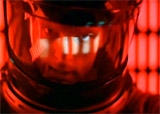
|
| 20. In a movie crammed with impressive locales, from Mount Rushmore to Manhattan's swank Plaza Hotel, an empty prairie forever holds our imagination. When Cary Grant's hunted advertising executive finds himself alone in the forlorn landscape, he learns director Alfred Hitchcock's hard lesson: You're not safe anywhere. A quaint-looking biplane drones into view, buzzing closer and closer, forcing a terrified Grant to take cover in a cornfield. Then Hitch springs his mordant joke: The plane is, of course, a crop duster, and thick clouds of poison begin to fall from the sky. The scene lasts nearly 10 minutes - an unthinkable indulgence by today's rapid-fire pacing - but not a second is wasted. |
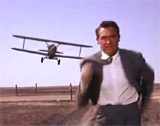
|
| 19. With an eerie calm, grizzled sea captain and World War II vet Quint recalls the 1945 sinking of the USS Indianapolis. Given true bite by Robert Shaw's haunted reading, the tale holds fellow shark hunters Richard Dreyfuss and Roy Scheider spellbound. Eyes glazed and distant, the flinty fisherman plunges us into the shark-infested South Pacific bloodbath that claimed more than 700 sailors. [This is an exaggeration of the truth!] For a few minutes, we forget the great white shark of the title as we're transported back into history. Originally just a passing reference in the script, Shaw rewrote the monologue that director Steven Spielberg himself considers the best scene in the monster hit. As much as we love that first midnight shark attack, who are we to disagree? |

|
| 18. The Exorcist (1973)
- THE FULL SWIVEL Who knew a musty old religious rite could be so terrifying? The climactic exorcism from William Friedkin's exercise in supreme horror was one of the single most awaited moments of 1973, the big battle between good and evil finally arriving after more than 90 minutes of pea-soup vomit and satanic verses. As the holy water is splashed and curses spewed, Linda Blair's head-turning performance as a child with demons shifts into overdrive. Fathers Merrin and Karras (Max von Sydow and Jason Miller) faithfully try to cure what ails her, but conventional techniques fail. When the younger priest finally takes matters into his own hands - yeah, he beats the devil out of the girl - viewers were (and are) on the edge of their seats. Or under them. |
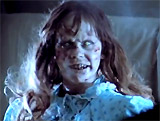 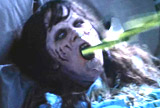 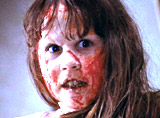
|
| 17. Battleship Potemkin (1925) - THE ODESSA
STEPS Considered by many to be one of the ten greatest films of all time, Sergei Eisenstein's Russian chronicle of a 1905 revolutionary uprising practically invented such now-standard editing techniques as the montage and the symbolic juxtaposition of shots. But this silent masterpiece's masterpiece is the massacre on the Odessa steps. Czarist troops relentlessly march down a long staircase, shooting at innocent men, women and children, culminating in the indelible image of a baby carriage bouncing down the stairs. Today's audiences might know the scene more from the many homages and parodies, in movies ranging from Brazil (1985) to The Untouchables (1987) to Naked Gun 33 1/3: The Final Insult (1994), yet the real thing has lost none of its power. |
 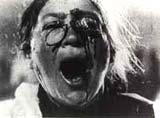 
|
| 16. Gregory Peck won an Academy Award for his role as the quietly heroic attorney Atticus Finch, but his isn't the only riveting performance in director Robert Mulligan's exquisite adaptation of Harper Lee's novel. Mary Badham is unforgettable as Scout, the little tomboy, and her poignant introduction to the town bogeyman, Boo Radley, is pure wonderment. Arriving near the end of the movie, the scene also introduced audiences to the man who played Boo: Robert Duvall. The actor's lone scene lasts no more than three minutes, but producer Alan Pakula once described it as the "reason to make the film." After rescuing Scout and her brother Jem from a vicious attack, Duvall's Boo appears like an angel come to earth. Scout's wide-eyed welcome - "Hey, Boo" - was the perfect greeting, a child's awakening to the power of good. |
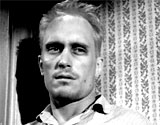
|
| 15. The Seven Year Itch
(1955) - THE SUBWAY BREEZE Marilyn Monroe and director Billy Wilder would reteam to make a better movie (1959's Some Like It Hot), but The Seven Year Itch earns its place in celluloid history (and pop-culture iconography) with the now-ingrained image of Marilyn astride a subway grate, her white, airy dress billowing high enough to beguile audiences and enrage real-life husband Joe DiMaggio. "Isn't it delicious?" she asks costar Tom Ewell, whose heat-soaked adulterous fantasies mirrored the nation's own. The movie is more discreet than the film's famous Times Square billboard ad: The skirt never flies much higher than the knees. But the image of Marilyn as a modern-day Venus rising from a New York City street remains, in a word, delicious. |
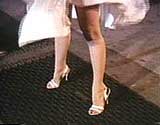
|
| 14. At the movies, we like our sentimentality the same way we like our popcorn: in shamelessly large servings. And the final scene in Frank Capra's Christmas classic - in which humble, hardworking George Bailey (Jimmy Stewart) discovers he is (as brother Harry says) "the richest man in town" - is the biggest, butteriest tub of all time. Can you imagine anyone but Stewart carrying off the emotional extremes of this role? Of course not. That's what makes him America's most beloved film actor. It's A Wonderful Life is the perfect vehicle for Stewart's heart-on-a-sleeve style, particularly when the despairing George finds out just how much his selflessness has meant to his family, friends, and community. No one but Capra could pull off the topper: When a tree ornament rings and little Zuzu tells her father that an angel just got his wings, George seems happier for his divine guardian Clarence than he is for himself. Go ahead and set aside a box of tissues for next Christmas. |

|
| 13. Elia Kazan's classic about Terry Malloy, a broken-down boxer battling a brutal and corrupt longshoreman's union, was filmed entirely in Hoboken, New Jersey, which would have made it a homecoming for the actor slated to star: Frank Sinatra. But Marlon Brando reversed his earlier refusal of the role and ended up giving Hollywood one of its greatest rides. In the scene that would become one of Brando's signature moments, Terry and his crooked older brother, Charley (Rod Steiger), sit in the back of a taxi, shadow and light flashing across their faces. Desperate to keep Terry from testifying against the local labor bosses, Charley tries bribery and threats. When Charley finally pulls a gun, Terry launches into a speech of equal parts regret, accusation and heartrending sadness. Charley, of course, contributed to his brother's long-ago downfall by cooperating with a rigged boxing match. "I coulda had class. I coulda been a contender," Terry says. "I coulda been somebody, instead of a bum, which is what I am, let's face it." In lesser hands, the speech would be little more than the bitter musings of a mug with "a one-way ticket to Palookaville." Brando transforms it into poetry. |

|